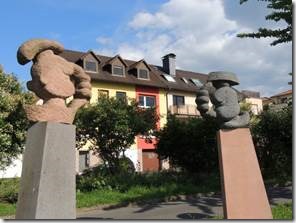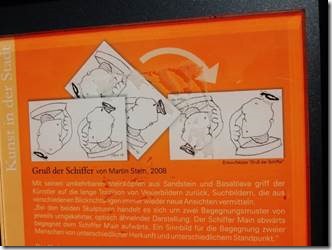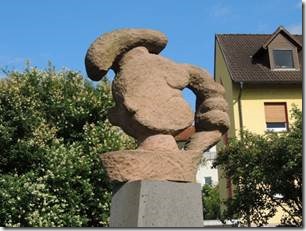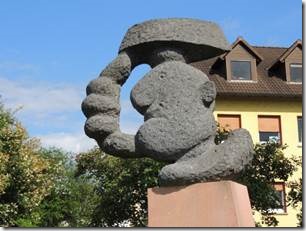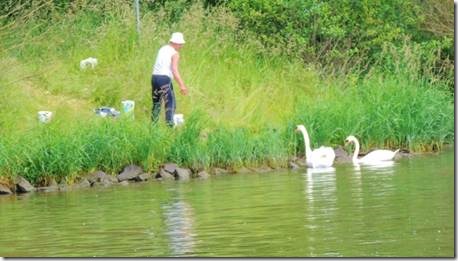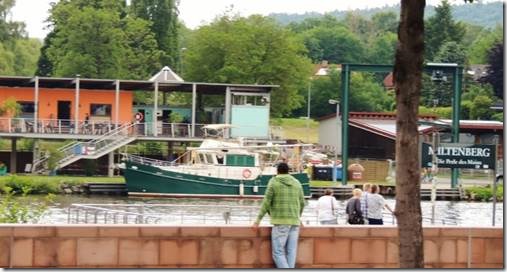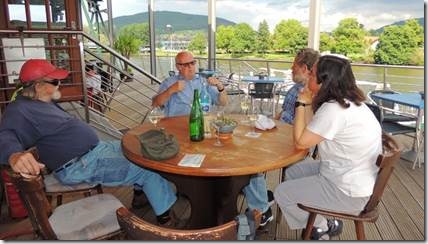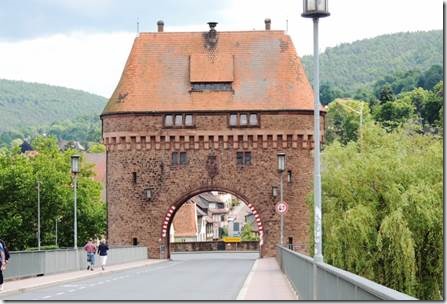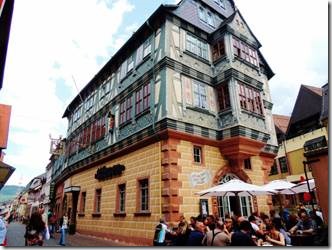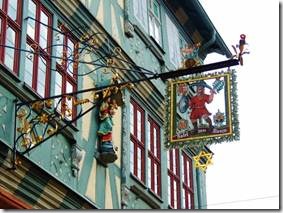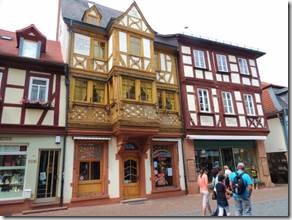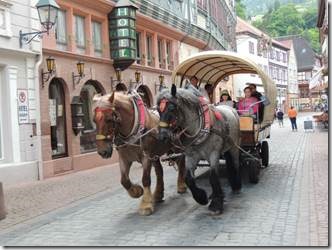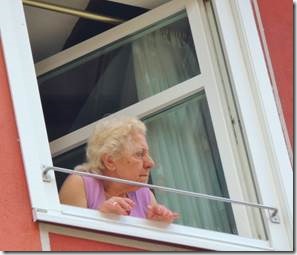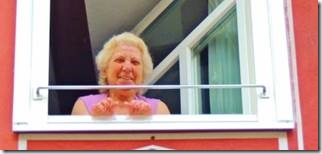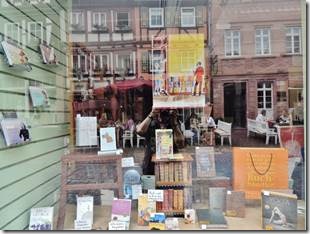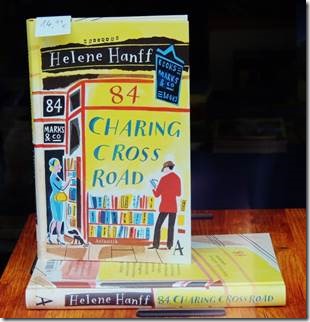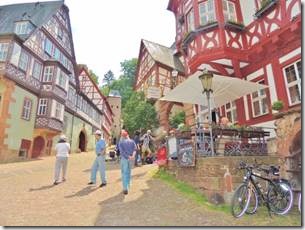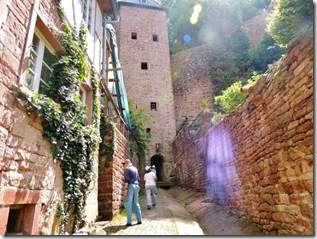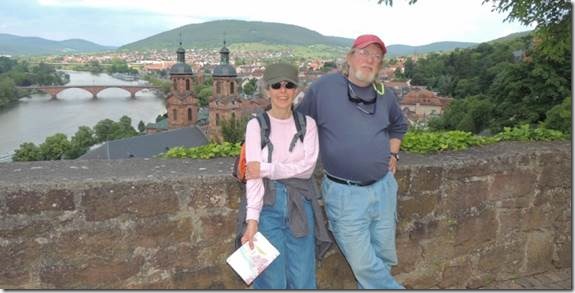On the way to Schleuse Knetzgau Kilometer 359.8 on the Main
Guten Morgen,
The biggest lock so far back at Ottendorf was so bad. But we had to wait a while for it. First there was a barge already inside and then we had to wait for a barge behind us to arrive for the lock to be opened for us. But it’s a bright sunny day so that’s good. We did have to drop the anchor again while waiting but it’s all mechanical so even that’s not a problem and the chain comes up clean so no wash-down necessary.
Last night we stayed in Schweinfert and tonight we’ll be someplace near Bamberg but unsure where just now. It will be another long day of over 50 kilometers and 4 locks. Hopefully we won’t have to wait as long to enter the next three. We’re cruising just behind the barge that we shared the lock with at Ottendorf so hopefully can follow him into the locks each time with no extra waiting.
Ru
DoraMac
“You don’t have to go all the way to Rothenburg ob der Tauber to see a pretty German town dressed for the holidays. Miltenberg has it all. The medieval marvel is one of the most attractive smaller towns in the center of Germany, impressing tourists with its cobbled streets and old architecture dating to the 13th century. The old town is ideal for walks and sight-seeing — the center is closed to traffic and provides spectacular scenery and unforgettable atmosphere in a small area.
Located on the southern shore of the Main River about 60 miles southeast of the busy metropolis of Frankfurt, Miltenberg’s attraction is a combination of its setting, sights and ambiance.
One of the highlights is the market square, which features half-timbered houses and a Renaissance fountain. Sitting above it is the Miltenburg castle. The scene is popular with artists, photographers and publishers of travel books and calendars, which often feature photos of the square.
The town museum, at Hauptstrasse 169, is known for its well-organized exhibitions of Miltenberg’s past and culture. Advent calendars from the past 100 years are now on display.
Another highlight is the restaurant and hotel Zum Riesen, one of the oldest guest houses in Germany. Erected in 1590, the Riesen’s interior recently was renovated by the Faust brewery, which is located down the street. This year the owners of the brewery, which offers group tours with beer tasting, earned first prize in a local architectural contest called “New Life in an Old Place.”
|
Sculptures in Aschaffenberg where we spent one night and walked into town for groceries and to stretch our legs. Fun sculpture : Greeting the “Schiffer” by Martin Stein Stein in German means stone. But I can’t find a translation for Schiffer. |
|
On the river on our way to Miltenberg This man was feeding the swans. They are everywhere and quite lovely. But when they take off to fly it’s the silliest thing to watch. It’s like a jumbo jet flopping along. They come up and beg for food and wag their tail feathers too. |
|
Miltenberg Yacht Club where we spent one night. We arrived at 1 pm so had time to tour the town. Having a drink with the Harbor Master after our day in town. |
|
We walked across the bridge to enter the Altstadt ‘old town.’ |
|
Zum Riesen Gasthaus zum Riesen (center) is a beautifully restored inn that claims to be Germany’s oldest Inn. It dates from 1590, and a local historical document indicates that the owner at the time was granted the right to fell a hundred oak trees for its construction. The Six-Point Brewer’s Star For centuries, it was customary for brewers — particularly those in Europe and, later, in America — to brand or paint a six-point star on the ends of their beer kegs. And, indeed, many brewers of the 19th and early 20th centuries actually fashioned their logos to incorporate the six-point star — known as the "brewer’s star." So, what exactly does the star have to do with beer or brewing? Of course, there has been much speculation that the brewer’s emblem was somehow descended from the Star of David — a curious match to the brewer’s star. It has even been suggested that King David himself was a brewer. But others assert that the emblem’s use by beer-makers originated independently of the Jewish Star, and has no historical connection thereto. The latter have some historical facts on their side. This geometric figure, which is technically called a hexagram, has existed throughout the world for several millennia, usually as a talisman. This includes the Middle East, Africa, and the Far East. The earliest appearance in a Jewish context is in the 13-16 centuries BCE, but long after that it continued in widespread use in other circumstances not associated with the Jewish faith. The first use of the term "Shield of David" was about 1300 CE when a Spanish practitioner of Jewish mysticism wrote a commentary on the central book of that mysticism, the Zohar. The first actual linkage of the hexagram to a Jewish community appears in the early 1300s on the flag of the Jewish community of Prague, which was designed with permission of Charles IV when he became king of Bohemia. It is known that the star was the official insignia of the Brewer’s Guild as early as the 1500s, and that its association with beer and brewing can be traced as far back as the late 1300s. Whatever the case, it is clear that the brewer’s star was intended to symbolize purity; that is, a brewer who affixed the insignia to his product was thereby declaring his brew be completely pure of additives, adjuncts, etc. In fact, folklore has it that the six points of the star represented the six aspects of brewing most critical to purity: the water, the hops, the grain, the malt, the yeast, and the brewer. (Thanks to Stroh archivist Peter Blum and Brews Brother Steve Frank.) http://www.beerhistory.com/library/holdings/brewerstar.shtml |
|
Miltenberg is a major tourist town for Germans but most of the tourists I heard the Sunday we were there were from the US. The horse and carriage reminded me of the months I worked in the stable of Lake Minnewaska in New Paltz, New York. |
|
Another “window lady.” |
|
This book shop was closed so I couldn’t go in and ask about the display featuring Helen Hanff’s 84 Charing Cross Road. It’s a wonderful book I read years ago and Randal and I visited the “address” while in London though it’s no longer a book shop. |
|
“Miltenberg’s "Marktplatz" has several half-timbered houses, most dating to the 16th century. “ and a small castle where we walked to see the view. |
|
The view from Miltenberg Castle |

